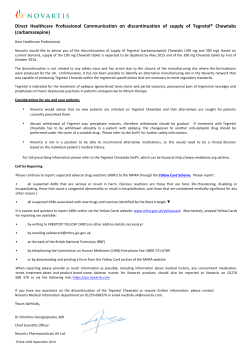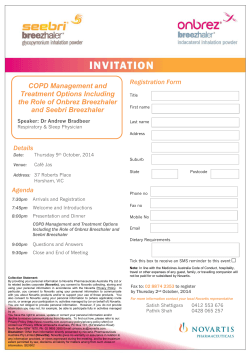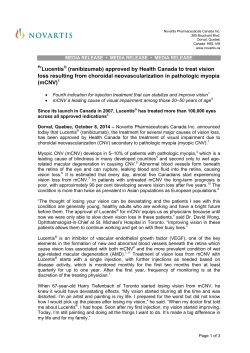
European Commission approves Novartis drug Tasigna for treatment
Novartis International AG Novartis Global Communications CH-4002 Basel Switzerland http://www.novartis.com MEDIA RELEASE • COMMUNIQUE AUX MEDIAS • MEDIENMITTEILUNG European Commission approves Novartis drug Tasigna® for treatment of patients with newly diagnosed Ph+ chronic myeloid leukemia Pivotal Phase III data show superiority over standard of care Glivec® in achieving molecular and cytogenetic response, delaying cancer progression Tasigna approval gives newly diagnosed patients new medical option; European Union joins US, Switzerland and Japan, other submissions under review Basel, December 23, 2010 — Novartis received approval today from the European Commission for Tasigna® (nilotinib) as a treatment for adult patients with newly diagnosed Philadelphia chromosome-positive chronic myeloid leukemia (Ph+ CML) in chronic phase. The approval from the European Commission followed a positive opinion from the Committee for Medicinal Products for Human Use (CHMP). It is based on findings from a pivotal Phase III trial demonstrating superiority to the standard of care Glivec® (imatinib)* in achieving molecular and cytogenetic response and delaying cancer progression. These data were first published in the June 17 issue of The New England Journal of Medicine1 and were confirmed by 18-month median follow-up data presented at the 46th American Society of Clinical Oncology (ASCO) annual meeting held in June2. The US Food and Drug Administration (FDA), Swissmedic and Japan's Ministry of Health, Labour and Welfare have also approved Tasigna in this first-line indication. Regulatory submissions are under review in other countries worldwide. ―We are pleased that Tasigna is now approved for newly diagnosed Ph+ CML patients in chronic phase in the member states of the European Union,‖ said Hervé Hoppenot, President, Novartis Oncology. ―With this expanded indication, newly diagnosed patients can benefit from a Bcr-Abl tyrosine kinase inhibitor that, according to pivotal data, surpassed the standard of care Glivec, in key measures of efficacy, including delaying disease progression at 12 months.‖ In laboratory studies, Tasigna has been shown to be a potent and selective inhibitor of the Bcr-Abl protein that causes production of cancer cells in Ph+ CML3,4. It has also been shown to be active against a broad spectrum of Bcr-Abl mutations associated with resistance to Glivec5. In its pivotal head-to-head trial, Tasigna surpassed Glivec in key measures of treatment efficacy, as has been reported. Tasigna eliminated Bcr-Abl faster and more deeply than Glivec and resulted in lower rates of cancer progression after 12 months of therapy1. Major molecular response (MMR), a measure of deep reduction in Bcr-Abl, is considered to be a critical therapeutic milestone associated with good long-term outcomes for patients with Ph+ CML in chronic phase6-8. Treatment with Tasigna led to higher rates of both MMR and complete cytogenetic response (CCyR) (undetectable levels of the Philadelphia chromosome that is the hallmark of this cancer) compared with Glivec1. *Known as Gleevec® (imatinib mesylate) tablets in the US, Canada and Israel. 1/5 After a median of 18 months of follow-up treatment, two patients on the Tasigna 300 mg twice daily arm progressed to either accelerated phase or blast crisis while 17 patients on the Glivec arm progressed to either accelerated phase or blast crisis. In the study, Tasigna and Glivec were generally well tolerated. Fewer patients discontinued due to adverse events from the Tasigna 300 mg twice daily arm of the study compared to the Glivec 400 mg once daily arm. The randomized, open-label, multicenter trial, called ENESTnd (Evaluating Nilotinib Efficacy and Safety in Clinical Trials of Newly Diagnosed Ph+ CML Patients), compared the efficacy and safety of Tasigna versus Glivec in adult patients with newly diagnosed Ph+ CML in chronic phase1. It is the largest global randomized comparison of two oral therapies ever conducted in newly diagnosed Ph+ CML patients in chronic phase. This year, Novartis also began a collaboration with molecular diagnostics company Cepheid to develop a new FDA cleared/approved Bcr-Abl test, which adheres to the International Scale. The goal of the collaboration is to help doctors more reliably monitor Ph+ CML patients. Cepheid and Novartis also will develop a next generation test, which is expected to enable even more sensitive testing, indicating the depth of a patient’s response to tyrosine kinase inhibitors, including Tasigna and Glivec. Currently, there are no FDA cleared/approved tests to monitor for Bcr-Abl. About Tasigna3 Tasigna is indicated for the treatment of adult patients with newly diagnosed Philadelphia chromosome-positive chronic myelogenous leukemia (CML) in the chronic phase. Tasigna has also been approved in over 90 countries for the treatment of chronic phase and accelerated phase Ph+ CML in adult patients resistant or intolerant to at least one prior therapy, including Glivec. The effectiveness of Tasigna for this indication is based on confirmed hematologic and unconfirmed cytogenetic response rates. There are no controlled trials demonstrating a clinical benefit, such as improvement in disease-related symptoms or increased survival. Tasigna important safety information Tasigna should be taken twice daily at an interval of approximately 12 hours apart and must not be taken with food. No food should be consumed for two hours before the dose and for at least one hour after the dose. Avoid grapefruit juice and other foods that are known to inhibit CYP3A4. Tasigna should not be used in patients who are hypersensitive to nilotinib or any of the excipients. Treatment with Tasigna has been associated with hematological side effects such as thrombocytopenia, neutropenia and anemia, which was generally reversible and usually managed by withholding Tasigna temporarily or dose reduction. Complete blood counts should be performed every two weeks for the first two months and then monthly thereafter as clinically indicated. Tasigna should be used with caution in patients with uncontrolled or significant cardiac disease (e.g., recent heart attack, congestive heart failure, unstable angina or clinically significant bradycardia), as well as in patients who have or may develop prolongation of QTc. These include patients with abnormally low potassium or magnesium levels, patients with congenital long QT syndrome, patients taking anti-arrhythmic medicines or other drugs that may lead to QT prolongation. Low levels of potassium or magnesium must be corrected prior to Tasigna administration. Close monitoring for an effect on the QTc interval is advisable and a baseline electrocardiography is recommended prior to initiating therapy with Tasigna and as clinically indicated. Uncommon cases (0.1 to 1%) 2/5 of sudden death have been reported in clinical studies in patients with significant risk factors. Tasigna should be used with caution in patients with liver impairment, in patients with a history of pancreatitis and in patients with total gastrectomy. Patients with rare hereditary problems of galactose intolerance, severe lactase deficiency or glucose-galactose malabsorption should not use Tasigna. Tasigna should not be used during pregnancy unless clearly necessary and breast feeding is not recommended during treatment. The most frequent Grade 3 or 4 adverse events for Tasigna were primarily hematological in nature and included neutropenia and thrombocytopenia. Elevations seen in bilirubin, liver function tests, lipase enzymes and blood sugar were mostly transient and resolved over time. These cases were easily managed and rarely led to discontinuation of treatment. Pancreatitis was reported in less than 1% of cases. The most frequent nonhematologic drug-related adverse events were rash, pruritus, nausea, fatigue, headache, alopecia, myalgia, constipation and diarrhea. Most of these adverse events were mild to moderate in severity. About Glivec9 Glivec is approved in more than 110 countries, including the US, EU and Japan, for the treatment of all phases of Ph+ CML. Glivec is also approved in the US, EU and other countries for the treatment of patients with Kit (CD117)-positive gastrointestinal tumors (GIST), which cannot be surgically removed and/or have already spread to other parts of the body (metastasized). In the US and EU, Glivec is now approved for the post-surgery treatment of adult patients following complete surgical removal of Kit (CD117)-positive gastrointestinal stromal tumors. In the EU, Glivec is also approved for the treatment of adult patients with newly diagnosed Ph+ acute lymphoblastic leukemia (Ph+ ALL) in combination with chemotherapy and as a single agent for patients with relapsed or refractory Ph+ ALL. Glivec is also approved for the treatment of adult patients with unresectable, recurrent and/or metastatic dermatofibrosarcoma protuberans (DFSP) who are not eligible for surgery. Glivec is also approved for the treatment of patients with myelodysplastic/myeloproliferative diseases (MDS/MPD). Glivec is also approved for hypereosinophilic syndrome and/or chronic eosinophilic leukemia (HES/CEL). The effectiveness of Glivec is based on overall hematological and cytogenetic response rates and progression-free survival in CML, on hematological and cytogenetic response rates in Ph+ ALL, MDS/MPD, on hematological response rates in systemic mastocytosis (SM), HES/CEL, on objective response rates and progression-free survival in unresectable and/or metastatic GIST, on recurrence free survival in adjuvant GIST and on objective response rates in DFSP. Increased survival in controlled trials has been demonstrated only in newly diagnosed chronic phase CML and GIST. Not all indications are available in every country. Glivec important safety information The majority of patients treated with Glivec in clinical trials experienced adverse events at some time. Most events were of mild to moderate grade and treatment discontinuation was not necessary in the majority of cases. The safety profile of Glivec was similar in all indications. The most common side effects included nausea, superficial edema, muscle cramps, skin rash, vomiting, diarrhea, abdominal pain, myalgia, arthralgia, hemorrhage, fatigue, headache, joint pain, cough, dizziness, dyspepsia and dyspnea, dermatitis, eczema and fluid retention, as well as neutropenia, thrombocytopenia and anemia. Glivec was generally well tolerated in all of the studies that were performed, either as monotherapy or in combination with chemotherapy, with the exception of a transient liver toxicity in the form of transaminase elevation and hyperbilirubinemia observed when Glivec was combined with high dose chemotherapy. 3/5 Rare/serious adverse reactions include: sepsis, pneumonia, depression, convulsions, cardiac failure, thrombosis/embolism, ileus, pancreatitis, hepatic failure, exfoliative dermatitis, angioedema, Stevens-Johnson syndrome, renal failure, fluid retention, edema (including brain, eye, pericardium, abdomen and lung), hemorrhage (including brain, eye, kidney and gastrointestinal tract), diverticulitis, gastrointestinal perforation, tumor hemorrhage/necrosis and hip osteonecrosis/avascular necrosis. Patients with cardiac disease or risk factors for cardiac failure should be monitored carefully and any patient with signs or symptoms consistent with cardiac failure should be evaluated and treated. Cardiac screening should be considered in patients with HES/CEL, and patients with MDS/MPD with high level of eosinophils (echocardiogram, serum troponin level). Glivec is contraindicated in patients with known hypersensitivity to imatinib or any of its excipients. Women of childbearing potential should be advised to avoid becoming pregnant while taking Glivec. Disclaimer The foregoing release contains forward-looking statements that can be identified by terminology such as ―under review,‖ ―to develop,‖ ―goal,‖ or similar expressions, or by express or implied discussions regarding potential new indications or labeling for Tasigna or regarding potential future revenues from Tasigna or Glivec. You should not place undue reliance on these statements. Such forward-looking statements reflect the current views of management regarding future events, and involve known and unknown risks, uncertainties and other factors that may cause actual results with Tasigna and Glivec to be materially different from any future results, performance or achievements expressed or implied by such statements. There can be no guarantee that Tasigna will be approved for any additional indications or labeling in any market. Nor can there be any guarantee that Tasigna or Glivec will achieve any particular levels of revenue in the future. In particular, management’s expectations regarding Tasigna and Glivec could be affected by, among other things, unexpected regulatory actions or delays or government regulation generally; unexpected clinical trial results, including unexpected new clinical data and unexpected additional analysis of existing clinical data; competition in general; government, industry and general public pricing pressures; the company’s ability to obtain or maintain patent or other proprietary intellectual property protection; the impact that the foregoing factors could have on the values attributed to the Novartis Group's assets and liabilities as recorded in the Group's consolidated balance sheet, and other risks and factors referred to in Novartis AG’s current Form 20-F on file with the US Securities and Exchange Commission. Should one or more of these risks or uncertainties materialize, or should underlying assumptions prove incorrect, actual results may vary materially from those anticipated, believed, estimated or expected. Novartis is providing the information in this press release as of this date and does not undertake any obligation to update any forward-looking statements contained in this press release as a result of new information, future events or otherwise. About Novartis Novartis provides healthcare solutions that address the evolving needs of patients and societies. Focused solely on healthcare, Novartis offers a diversified portfolio to best meet these needs: innovative medicines, cost-saving generic pharmaceuticals, preventive vaccines, diagnostic tools and consumer health products. Novartis is the only company with leading positions in these areas. In 2009, the Group’s continuing operations achieved net sales of USD 44.3 billion, while approximately USD 7.5 billion was invested in R&D activities throughout the Group. Headquartered in Basel, Switzerland, Novartis Group companies employ approximately 100,000 full-timeequivalent associates and operate in more than 140 countries around the world. For more information, please visit http://www.novartis.com. 4/5 Novartis is on Twitter. Sign up to follow @Novartis at http://twitter.com/novartis. References 1 2 3 4 5 6 7 8 9 Saglio G, Kim D-W, Surapol Issaragrisil S, et al. Nilotinib versus imatinib for newly diagnosed chronic myeloid leukemia. N Engl J Med. 2010 Jun 17;362(24):2251-9. Larson R, Philipp le Coutre, Reiffers J, Hughes T. et al. Nilotinib is Superior to Imatinib in Patients (pts) with Newly Diagnosed Chronic Myeloid Leukemia in Chronic Phase (CML-CP): ENESTnd Beyond One Year. Abstract # CRA6501. American Society of Clinical Oncology 2010 Annual Meeting. Novartis data on file. le Coutre P, Ottmann OG, Giles F, et al. Nilotinib (formerly AMN107), a highly selective BCR-ABL tyrosine kinase inhibitor, is active in patients with imatinib-resistant or-intolerant accelerated-phase chronic myelogenous leukemia. Blood. 2008 Feb 15;111(4):1834-9. Swords R, Mahalingam D, Padmanabhan S, et al. Nilotinib: optimal therapy for patients with chronic myeloid leukemia and resistance or intolerance to imatinib. Drug Des Devel Ther. 2009 Sep 21;3:89101. Hochhaus A, O'Brien SG, Guilhot F,et al. IRIS Investigators. Six-year follow-up of patients receiving imatinib for the first-line treatment of chronic myeloid leukemia. Leukemia. 2009 Jun;23(6):1054-61. Müller MC, Hanfstein B, Erben P, et al. Molecular response to first line imatinib therapy is predictive for long term event free survival in patients with chronic phase chronic myelogenous leukemia – an interim analysis of the randomized German CML Study IV. Blood (ASH Annual Meeting Abstracts) 2008, 112: Abstract 333. Baccarani M, Cortes J, Pane F, et al. Chronic myeloid leukemia: an update of concepts and management recommendations of European LeukemiaNet. J Clin Oncol. 2009 Dec 10;27(35):6041-51. ® Glivec (imatinib) prescribing information. Basel, Switzerland: Novartis International AG; March 2009. ### Novartis Media Relations Central media line : +41 61 324 2200 Eric Althoff Novartis Global Media Relations +41 61 324 7999 (direct) +41 79 593 4202 (mobile) eric.althoff@novartis.com Amy Vinci Novartis Oncology +1 862 778 6309 (direct) amy.vinci@novartis.com e-mail: media.relations@novartis.com For Novartis multimedia content, please visit www.thenewsmarket.com/Novartis For questions about the site or required registration, please contact: journalisthelp@thenewsmarket.com. Novartis Investor Relations Central phone: Susanne Schaffert Pierre-Michel Bringer Thomas Hungerbuehler Isabella Zinck +41 61 324 7944 +41 61 324 3769 +41 61 324 1065 +41 61 324 8425 +41 61 324 7188 e-mail: investor.relations@novartis.com North America: Richard Jarvis Jill Pozarek Edwin Valeriano +1 212 830 2433 +1 212 830 2445 +1 212 830 2456 e-mail: investor.relations@novartis.com 5/5
© Copyright 2025

















